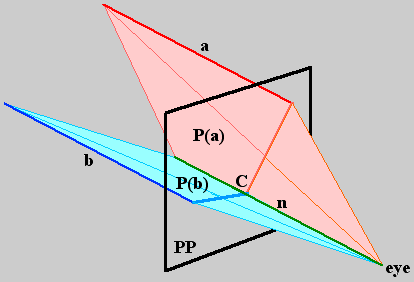

This column is an elaboration and an animation
of the geometry contained in my review
of The Invention of Infinity by J. V. Field (Oxford, 1997); the
review appeared in the Notices of the A.M.S. and is available
online.
For cultural background and a much more detailed look at the history
please consult Field's book or The Heritage of Giotto's Geometry
by Samuel Y. Edgerton, Jr. (Cornell, 1991).

An important feature of one-point perspective is the vanishing point:
 |
The proof, sketched here, is an argument in solid geometry: By the construction, any straight line a in space appears as a straight line in the picture (the intersection of the picture-plane PP with the plane P(a) determined by a and the eye). If a is perpendicular to PP, then at any intersection point x of P(a) with PP the line through x in P(a) parallel to a will also be perpendicular to PP. If b is another line in space, then P(a) and P(b) intersect (they both contain the eye). Their intersection will be a line n. If b is also perpendicular to PP, then a and b are parallel, and so both are parallel to n. So n is a line through the eye which meets PP perpendicularly, in a point C. Since C belongs to PP, P(a) and P(b), the lines in the picture corresponding to a and b must intersect in C: C is the vanishing point. |
It is often said that the ancients knew one-point perspective and that it was ``rediscovered'' in the Renaissance. But in the works from Roman times that I have examined, where the artists were using linear perspective to create the illusion of depth, there was not this systematic organizing principle. In particular there is no global vanishing point. As a consequence the images grow more unlikely the more closely they are studied, sometimes ending up with impossible, Escher-like configurations (as remarked in Michael Gunther's website Roman Painting: Frescoes from Campania (see in particular Theatrical Scenery and III Style Decoration; see also the cityscape from Boscoreale on the Odyssey website and the sumptuous and perplexing mural from John Hauser's ``Pictures of History - Pompeii.'')
There is more to one-point perspective than the vanishing point. The most delicate question is the following: given a series of equally spaced points along a line perpendicular to the picture-plane, how will their images be spaced along the corresponding straight line in the picture? The answer is straightforward to calculate numerically but for an artist it would be very awkward to have to reckon all the distances and measure them off, one by one, in the picture.
In this column we will investigate a geometric algorithm for generating these lengths with no calculation. The method was invented in Florence at the beginning of the 15th century, probably by Filippo Brunelleschi. It was written up by Leon Battista Alberti in 1435-36; the simplified version, described by Piero della Francesca around 1480, will be the focus of our attention.
--Tony Phillips
Stony Brook
|
|
|
© Copyright 2001, American Mathematical Society |